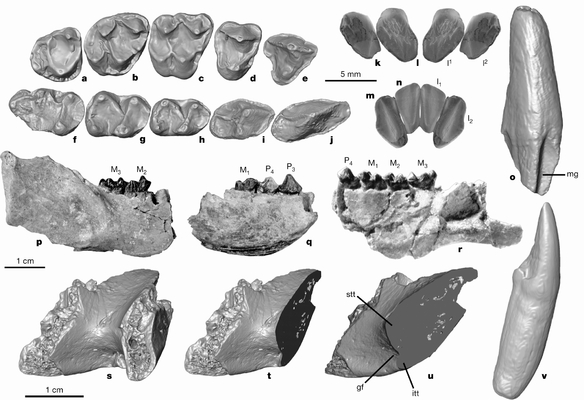
by Erin Wayman Thursday, January 5, 2012

Teeth and jaw remains of _Afradapis_. Erik Seiffert et al., Nature 2009
Darwinius — the purported primate “missing link” that made headlines last spring — is back, sort of. Scientists have now found a close cousin of the primate — and they say the new fossil is no more a missing link than Darwinius was.
Erik Seiffert of Stony Brook University in New York and colleagues have found bits of jaw and teeth from a 37-million-year-old species they named Afradapis longicristatus. After analyzing the remains, they determined the species was closely related to Darwinius — and that neither Afradapis nor Darwinius was the common ancestor of monkeys and apes (including humans), in contrast to a claim made by Darwinius’ discoverers. Instead, both species belong to an extinct lineage of primates that left no living descendants.
The researchers uncovered Afradapis in northern Egypt’s famed Fayum Depression. Although now a desert, the Fayum was a bustling tropical forest in the Late Eocene and Early Oligocene (roughly 37 million to 30 million years ago). Weighing an estimated 2 to 3 kilograms (about the size of a chihuahua), Afradapis would have towered over its primate neighbors. In fact, Seiffert and the team say the new species is the largest known primate from that area at the time.
The researchers say Afradapis belongs to an extinct group of primates called the adapiforms, which resembled modern lemurs. Recent studies indicate adapiforms are indeed distantly related to lemurs as well as to their cousins, the lorises and galagos (aka bush babies) — and all of these species are sometimes referred to as the most “primitive” primates.
But some scientists say adapiforms are more like the “higher” primates — monkeys and apes, including humans — particularly when it comes to their teeth. And that’s the view that the team that discovered Darwinius seems to prefer: Not only did that team identify Darwinius as an adapiform, the team also claimed that Darwinius was the earliest ancestor of monkeys and apes.
Seiffert and his colleagues enter into that debate in the Nature paper. They constructed a family tree of 117 living and extinct primates, including Afradapis and Darwinius, based on 360 physical features. The resulting tree shows that Afradapis and Darwinius are closely related and that the two primates are firmly rooted in the strepsirrhine suborder — the group that includes those most primitive primates, such as lemurs.
If their analysis is right, neither Afradapis nor Darwinius is an ancestor of the higher primates: monkeys and apes.
Still, Afradapis, like the other adapiforms, did have many dental features resembling those of higher primates — including an upper canine tooth that sharpens itself on a lower premolar (or bicuspid) and a fully fused lower jaw. So what does that mean?
Seiffert and colleagues conclude it’s a case of convergent evolution — different species evolving a common trait independently. And although neither Darwinius nor Afradapis may be a key missing link for primates, the dental similarities that they share with higher primates still makes the adapiforms important to study, the team says. What it does mean is that the adapiforms probably shared a similar feeding ecology with the earliest ancestors of monkeys and apes — and thus, by studying adapiforms, researchers may gain a better understanding of the selective pressures that led to the emergence of the monkey-ape lineage.
© 2008-2021. All rights reserved. Any copying, redistribution or retransmission of any of the contents of this service without the expressed written permission of the American Geosciences Institute is expressly prohibited. Click here for all copyright requests.